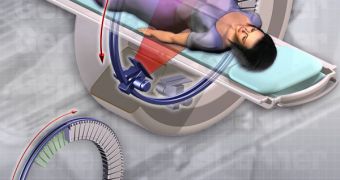CT imaging consists of X-rays sent through the body to produce digitized signals that can be detected and reconstructed by computers. Each of the 256 detectors on the new machine picks up a "slice" of an organ or tissue. The more detectors, the better is the resolution of the picture.
A computer puts all the slices together to render detailed, 3-D images of the heart or brain and surrounding arteries. In some cases, a patient is injected with a contrast solution to increase the visual detail.
Johns Hopkins Medicine, in East Baltimore, U.S., has installed a 256-slice computed tomography (CT) scanner, believed to be the world's most advanced CT imaging software and machinery, for three moths of initial safety and clinical testing.
The Aquilion beta 256, constructed by Toshiba, weighs 2 metric tons, is the first of its kind outside of Japan, the home of the manufacturer, has four times the detection coverage of its predecessor, the 64-CT and a staggering price tag of more than $1 million, with negotiations for its purchase on the way.
It can measure subtle changes in blood flow or minute blockages forming in blood vessels no bigger than the average width of a toothpick (1.5 millimeters) in the heart and brain, as cardiologist Joao Lima, M.D., who will lead cardiovascular testing, says : "The scanner's strength means it can find the earliest signs of restricted blood flow, long before symptoms appear or an organ becomes permanently damaged even though blockages in arteries, veins or capillaries in any organ can simmer for years, with signs of chest pain, severe fatigue and headache emerging only after the disease has become seriously life-threatening."
The most important technological advance of the 256-CT, essentially a doughnut-shaped metal ring, called a central gantry, is its greater number of detectors, which cover in a single scan four times the area of the 64-CT, thus a single rotation of the device's X-ray-emitting gantry can image a diameter of 12.8 centimeters (or 5 inches), a slice thick enough to capture most individual organs in one swoop, including the brain and heart, entire joints, and most of the lungs and liver.
Multiple advantages provide the new scanner with a promising future, as it will be imaging the brain in less than 1 second, at a data traffic of 5 to 10 gigabytes per scan and without any cooling system for the gantry, only for the computer hardware.
From the patient's point of view, exposing them to far less radiation, as little as one-eighth to one-third of the dose required in testing with the 64-slice scanner can only be an additional benefit.

 14 DAY TRIAL //
14 DAY TRIAL //